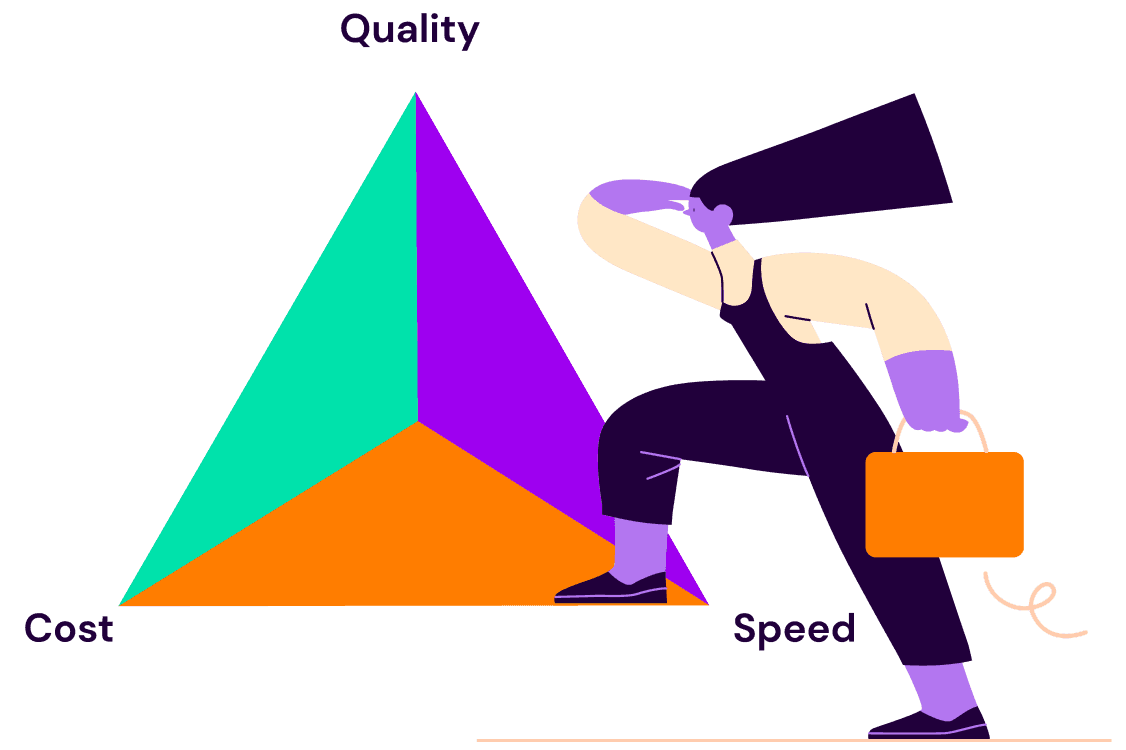
Back to blogs
The skills-based organization has long been an elusive concept for HR leaders: For those willing to embrace it, implementation has proven challenging, leaving organizations without the transformative results they hoped for. With the advancement of AI in recent years, however, there’s more clarity than ever around how to build and manage a skills infrastructure effectively to help drive business impact faster.
Ahead, we cover how a skills approach works, the benefits to greater business objectives, and how to start laying the groundwork to set you on the right path.
What is a skills-based organization?
A skills-based organization refers to a business that prioritizes the skills, capabilities, and learning potential of employees and candidates, rather than limiting a person’s qualifications to their degrees or previous job titles.
There is no universally accepted definition or model of a skills-based organization, but when implemented successfully, it can set the foundation for greater business agility and foster diverse, adaptable teams that drive uninterrupted innovation.
Skills-based organization examples: A concept in action
A skills-based approach to an organization’s workforce will look different with every business. Generally, however, an organization may manage a database that collects and categorizes every employee’s skills, which are all mapped to various job profiles. This structure offers insight into skills gaps and which skills are strongest amongst an organization’s workforce. The data also allows businesses to be more strategic over internal hiring, redeploying top talent, and future workforce planning.
A great skills-based organization example is Peraton, a national security company. They deployed an AI-powered, scalable skills solution to their 17,000 employees and have been able to increase retention and cost savings due to faster internal talent redeployment.
Other skills-based organization examples include:
Filling critical roles faster by hiring internally vs externally. When a role needs to be filled urgently, hiring teams can look at their existing talent as step one to determine if anyone’s skills and capabilities align with the job description. If there is a match (and the role matches the employee’s desired career path), not only can the hiring team save time by removing hours spent assessing and interviewing external candidates, but the employee can have quicker onboarding given that they already have deep knowledge of the company, culture, processes, and product or service.
Staffing projects faster. With a solid understanding of your employees’ experiences, skills, certifications, and backgrounds, talent teams have the data they need to align the right skills to the right roles. Teams can quickly identify who can staff short- or long-term projects (even gig work) without the need to spend unnecessary time looking outside the organization. This can be achieved through an Internal Talent Marketplace where employees can see available opportunities that align with their professional interests and goals.
Supporting retention with internal mobility opportunities. Making it easy for employees to find new internal opportunities has been shown to lower the risk of attrition. When an employee’s career path is clear to their managers, a skills-based approach offers the opportunity to fill skills gaps with learning opportunities so they can eventually move to their next role.
These are just a few examples of a skills-based organization use cases, but there are many more ways that businesses can leverage the wealth of skills data from their workforce to support short- and long-term objectives.
Key business advantages of a skills-based organization
Greater business agility
As market demands shift unpredictably, the need for business agility remains a priority for executive leadership. When a business is agile, it means the organization can adapt to both internal and external changes with precision, cost-efficiency, and speed.
Having clear insight into your workforce’s skills and career potential is an effective way for leaders and managers to adjust team sizes and realign talent to focus on top priorities, rather than spend time hiring and outsourcing.
Increased innovation
According to a survey by PwC, over half of CEOs say skills shortages and tech disruption will affect profitability over the next decade. Skills-based organizations that prioritize continued learning and the growth potential of the individual over narrow expertise and strictly defined roles can directly impact these concerns.
By fostering an environment that aligns the need of emerging skills with employee upskill and reskill opportunities, businesses can build a workforce that sustains innovation without setbacks.
More equitable workforce
A skills-based organization levels the playing field for employees who lack formal credentials but may have the right skills through informal learning and work experience. Inclusivity can be achieved when opportunities are presented, discovered, and filled when there’s less reliance on strict requirements and “who you know.”
A bonus to a skills-based organization is that it can also keep you ahead of future work culture trends, particularly the growing sentiment over the value of college degrees. According to Pew Research Center, nearly 30% of Americans say that college isn’t worth the cost and nearly half say that a four-year college degree is losing importance for landing well-paying jobs in today’s market. The makeup of formal education will likely shift in the years ahead, but a skills-based approach to both hiring and managing employees can keep businesses prepared.
Stronger employee engagement
When an organization leads with skills, it can better empower employees to understand their career development paths and growth opportunities. The approach leads to a stronger sense of belonging and increased employer satisfaction. Employees have an easier time fostering trust and commitment to an employer that invests time in their skill development and career growth.
The need for AI to manage skills-based organizations
To become a skills-based organization, many companies start by creating a skills taxonomy, either by building in-house or purchasing it off-the-shelf through a third-party vendor. A skills taxonomy can offer HR, managers, and employees some structure and consistency when communicating individual and collective competencies, but not without its challenges.
Off-the-shelf skills taxonomies don’t have enough coverage or granularity of skills to match what your company has, making this a substantial investment whether you decide to build or buy. There’s also the question of who will maintain the taxonomy. Teams face an ongoing tedium of keeping the taxonomy accurate and relevant as employee skills and business objectives evolve.

"The amount of effort it takes to build and maintain taxonomy updates is wasteful because as soon as the model is built, the skills and technologies have already changed. SeekOut’s AI tracks all our employees’ skills and allows them to update it in real time.”
Cari Bohley, VP of Talent Management, Peraton
AI-assisted technology like SeekOut Grow offers the opportunity to build skills-based organizations using an entirely different approach, enabling a dynamic system that:
Unifies huge amounts of disparate talent data across internal and external sources like HRIS, ATS, LMS, performance and productivity tools, social platforms, and more.
Understands skills at the semantic level, gleaning additional information and useful context. For example, a search for “project management” can match a resume stating “leads projects.”
Automatically enrich and update skills information on an ongoing basis to help maintain relevance.
Teams shouldn’t have to spend time getting lost in the weeds of perfecting a skills taxonomy or mapping skills to every job role in the company. AI-assisted technology can simplify the skills journey and keep teams focused on alleviating talent problems.
How to set your organization on the right path to becoming a skills-based organization
Betsy Summers, Principal Analyst at Forrester, regularly speaks to HR leaders who intend to or are undergoing a skills-based transformation. Based on many of those conversations, Betsy recommends starting small and gradually expanding to align with business goals.
First, identify the problem before spending any time on developing a skills taxonomy
Teams commonly overspend resources building a skills taxonomy and skills inventory without first understanding how these solutions can solve their talent challenges.
Whether it’s a talent shortage, upskilling, reskilling, or retention, it’s imperative that there’s alignment over the issues and the desired outcomes. Doing so will make it easier to strategize what resources are truly needed.
Get buy-in from leadership and build trust around AI
HR should not navigate the skills-based organization journey alone. Get executive leadership on board by framing how solving talent problems will directly impact business objectives. One way is to start with a small project to prove ROI. Target one skills challenge and build an experiment around it. The results will offer a preview of what investing in a full-fledged skills-based organization can look like for the business.
And it’s also common for leadership to be wary of investing in AI to solve these talent challenges. Betsy notes that building trust in the technology is key to overcoming this apprehension. Otherwise, organizations can fall behind on innovation and lose competitive edge in the market.
“The moment is about how to embrace this technology effectively, responsibly, and ethically so we can help our businesses move forward,” says Betsy. “Because without it, we’ll just be on the sidelines, and that is a risky position as well.”
Learn more about overcoming obstacles to build a skills-based organization with AI
For a deeper look into how AI is helping talent leaders drive faster impact with skills-based to hiring, upskilling, redeployment, and employee career growth, read our guide Future of Skills: How to Get Out of the Grunt Work and Start Solving Talent Problems with Skills.
See us in action
Learn how SeekOut unifies people data to help organizations reach their talent goals
Request a demo




